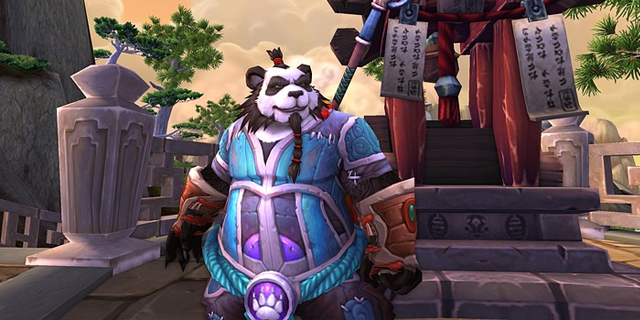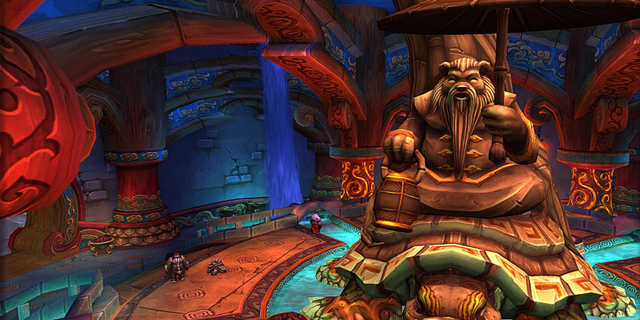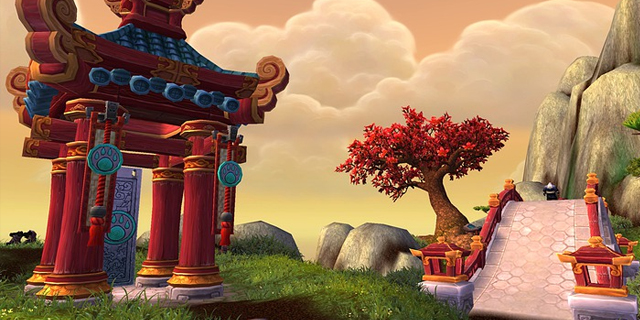
World of Warcraft has been a bit of a legend among MMOs. While not yet the longest-running game, it is certainly the game most people think of when they hear the term MMO. Mists of Pandaria is not going to bring back the multitudes of former players from six years ago — if someone simply dislikes the formula, Blizzard has elected not to change the core of the game to appeal to any new customers — at the risk of alienating the players it already has. WoW has declined in popularity in the past few years, down from 12 million players to 9, but 9 million players is still millions more than any other game has managed to achieve.
The main additions here are the Pandaren, both as a story element and as a playable race, and their new class, the Monk. As is standard for Blizzard, the game draws inspiration from pop culture and other media. Many draw similarities with the movie Kung-Fu Panda here, though I see more elements of the Dragon Ball series. As is usual, the seemingly-lighthearted side, showing them as goofy characters who love to drink, is countered with the militaristic Shado-Pan, who serve as the defenders of Pandaria.

Unlike previous expansions, there is no overall antagonist against which the two factions must face at the conclusion of a raid instance. Instead, the main antagonists become the opposing faction itself. Pandaria exists as a continent that becomes embroiled in the war between the Horde and the Alliance, and a recurring theme in the expansion is the effect the war has on the area. Not long after beginning, it becomes clear that the two factions are not as righteous or honorable as they claim to be.
While many see the Pandaren, and this expansion pack, as “silly,” I feel it fits in perfectly with the atmosphere of the game. Warcraft, in all of its forms, has never been a gripping drama. From its art style to its multitiude of pop culture references, the franchise has always been a bit of a caricature of the properties it draws inspiration from.
Mists of Pandaria features the usual assortment of new instanced dungeons and raids and a few new features for players not yet at the level cap, though as you might expect, the pack is designed for players who had reached level 85 in Cataclysm. The new dungeons feel less technical than the Cataclysm dungeons, and a bit more doable in a random group without excessive preparation. Character progression post-90 is as it always has been, based on upgrading your gear. Quests have been adjusted to always offer a reward that fits your class and spec, and of course, the usual token-based dungeon system is still here, meaning that you aren’t at the complete mercy of random drops.

Among the new additions are several activities not related to dungeons or questing, like Pet Battles and the Tillers in one of the new Pandaria zones, Valley of the Four Winds. Pet battles are essentially a system for leveling up and collecting mini-pets. It is really hard not to draw the obvious connection with Pokemon here, as that basically sums up what this new activity is. You can use almost all of your existing pets with this system, and you can search for random players to duel against. Pets level up to 25, and can only be used to fight other pets. When fighting wild pets, traps can be used to capture them. This system has an assortment of achievements associated with it, and has been designed to be usable by characters of all levels.
Farming is another new ability, though not technically a profession. The Tillers are the reputation faction closely linked with it, though progress is focused around impressing individual characters in return for their influence and assistance. It is closely connected with Cooking, and can be used to provide much of what is needed to progress through the new cooking skills. Initially, you will be able to grow four crops per day, this will increase as you gain levels and reputation.
World PvP is surprisingly missing from this expansion, though announced to be coming in the first major patch. There is currently no new zone filling the role of Wintergrasp or Tol Barad, which was surprising given the increased focus on the conflict between factions.
The game retains its competitive nature. Essentially, due to the mechanics behind resource gathering and questing, many players prefer to be alone, to speed collection and completion of these things. Given my experience in Guild Wars 2, this has begun to feel a bit annoying, as I would prefer having other players in my general area to improve the experience. I understand this is likely something that cannot be easily changed, but I hope Blizzard puts some thought into this for future games.
Mists of Pandaria is not a huge change in the Warcraft formula, but it does provide more of what players enjoyed about the previous expansions, with a few changes that improve the overall game. If you stopped playing simply because of content running out, or want to see what they’ve done in the last few years, it is worth a look.
Pros: More of what was good before, non-dungeon activities
Cons: Doesn’t change the competitive nature



















